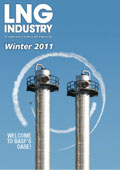Editorial comment
At the time of writing, the USA has taken a further step towards becoming an LNG export market. BG Group has secured LNG volumes for export from the USA to international gas markets, having signed an agreement with Sabine Pass Liquefaction, (subsidiary of Cheniere Energy Partners) for the purchase of 3.5 million tpy of LNG over a 20 year period from the Sabine Pass LNG terminal in Louisiana, USA. This marks the first long term LNG purchase agreement from a project on the US Gulf Coast, with construction of liquefaction facilities beginning next year, and exports commencing from 2015. BG Group Chief Executive Sir Frank Chapman said, “This is a groundbreaking agreement for BG Group, giving us first-mover advantage in securing LNG export volumes from the US Gulf Coast. It is the first agreement of its kind in this region and it secures us early access to the rapidly emerging commercial opportunities driven by the recent material increases in US gas reserves.”
Register for free »
Get started now for absolutely FREE, no credit card required.
October has also proved eventful for Canadian project, Kitimat LNG. Project partners; Apache Canada Ltd, EOG Resources Canada Inc. and Encana Corp. announced that Kitimat LNG had been granted a 20 year export licence to ship LNG from Canada to markets around the world. Kitimat LNG President Janine McArdle said in a statement that “The Kitimat LNG project represents a remarkable opportunity to open up Asia-Pacific markets to Canadian natural gas and we’re leading the way in being able to deliver a long term, stable and secure supply to the region.” Apache Canada President Tim Wall also noted that “Kitimat LNG will bring revenues and jobs and the associated benefits to Canada.”
Australia continues to be a hive of activity for LNG, and the projects there also promise to bring huge “revenues and jobs and the associated benefits” to Australia. However, there has been some talk of skills shortages creating a bottleneck in growth of business in this part of the world. Without enough people to go around, delays and escalating costs might be on the horizon, with the limited skilled workforce going to the projects willing to pay the highest wage. The booming LNG industry in Australia could prove to be a windfall to the experienced professionals who work there.
Overall, the LNG sector is experiencing a period of healthy growth, with predictions (according to the IEA) that global LNG trade, liquefaction and regasification will double by 2035. But it was not just the healthy growth of the LNG sector that was hitting the news headlines in October. State of World Population 2011; a major report from the UN, predicted that person number 7 billion will be born on 31 October. The report goes on to estimate that over 10 billion people will be alive in the world by the end of this century. Should we be proud of the fact that global average life expectancy has increased by 20 years since the 1950s? Or is this news of a worldwide crisis in the making? The answer is that there’s no crisis, so long as we can sustain the growing consumption that a growing population will bring with it. There will of course be increased competition for energy globally. LNG has the advantage of being a flexible solution to many countries’ short and long term energy problems.
We need to continue to develop not only new energy resources, but more efficient and innovative ways of using the resources that we already have. A lot of attention is currently being given to the benefits of utilising LNG as a ship fuel, methods of handling boil-off gas, and in this issue of LNG Industry we feature an interesting article, “Is LNG on track?” postulating on the possibilities surrounding the use of LNG to power locomotives.
It’s clear that the world has benefitted from the technological advancements inherent in LNG transportation, which is now considered as a vital and competitive part of the world’s energy mix. The sector will continue to grow and mature in the long term.

